Articles
- Page Path
- HOME > Restor Dent Endod > Volume 34(1); 2009 > Article
- Original Article Stress distribution for NiTi files of triangular based and rectangular based cross-sections using 3-dimensional finite element analysis
- Hyun-Ju Kim1, Chan-Joo Lee2, Byung-Min Kim2, Jeong-Kil Park1, Bock Hur1, Hyeon-Cheol Kim1
-
2009;34(1):-7.
DOI: https://doi.org/10.5395/JKACD.2009.34.1.001
Published online: January 31, 2009
1Department of Conservative Dentistry, School of Dentistry, Pusan National University, Busan, Korea.
2Division of Precision Manufacturing Systems, Pusan National University, Busan, Korea.
- Corresponding Author: Hyeon-Cheol Kim. Department of Conservative Dentistry, School of Dentistry, Pusan National University, 1-10 Ami-Dong, Seo-Gu, Busan, Korea. Tel: 82-51-240-7978, golddent@pusan.ac.kr
• Received: June 13, 2008 • Revised: July 3, 2008 • Accepted: July 8, 2008
Copyright © 2009 The Korean Academy of Conservative Dentistry
- 1,080 Views
- 6 Download
- 3 Crossref
Abstract
-
The purpose of this study was to compare the stress distributions of NiTi rotary instruments based on their cross-sectional geometries of triangular shape-based cross-sectional design, S-shaped cross-sectional design and modified rectangular shape-based one using 3D FE models.NiTi rotary files of S-shaped and modified rectangular design of cross-section such as Mtwo or NRT showed larger stress change while file rotation during simulated shaping.The stress of files with rectangular cross-section design such as Mtwo, NRT was distributed as an intermittent pattern along the long axis of file. On the other hand, the stress of files with triangular cross-section design was distributed continuously.When the residual stresses which could increase the risk of file fatigue fracture were analyzed after their withdrawal, the NRT and Mtwo model also presented higher residual stresses.From this result, it can be inferred that S-shaped and modified rectangular shape-based files were more susceptible to file fracture than the files having triangular shape-based one.
- 1. Sattapan B, Nervo GJ, Palamara JE, Messer HH. Defects in rotary nickel-titanium files after clinical use. J Endod. 2000;26(3):161-165.ArticlePubMed
- 2. Peters OA. Current challenges and concepts in the preparation of root canal systems: a review. J Endod. 2004;30(8):559-567.ArticlePubMed
- 3. Averbach RE, Kleier DJ. Endodontics in the 21st century: the rotary revolution. Compend Contin Educ Dent. 2001;22(1):27-34.
- 4. Yao JH, Schwartz SA, Beeson TJ. Cyclic fatigue of three types of rotary nickel-titanium files in a dynamic model. J Endod. 2006;32(1):55-57.ArticlePubMed
- 5. Pruett JP, Clement DJ, Carnes DL. Cyclic fatigue testing of nickel titanium endodontic instruments. J Endod. 1997;23(2):77-85.ArticlePubMed
- 6. Turpin YL, Chagneau F, Vulcain JM. Impact of two theoretical cross-sections on torsional and bending stresses of nickel-titanium root canal instrument models. J Endod. 2000;26(7):414-417.ArticlePubMed
- 7. Camps JJ, Pertot WJ, Levallois B. Relationship between file size and stiffness of nickel titanium instruments. Endod Dent Traumatol. 1995;11(6):270-273.ArticlePubMed
- 8. Camps JJ, Pertot WJ. Relationship between file size and stiffness of stainless steel instruments. Endod Dent Traumatol. 1994;10(6):260-263.ArticlePubMed
- 9. Kazemi RB, Stenman E, Spångberg LS. A comparison of stainless steel and nickel-titanium H-type instruments of identical design: torsional and bending tests. Oral Surg Oral Med Oral Pathol Oral Radiol Endod. 2000;90(4):500-506.ArticlePubMed
- 10. Schäfer E, Tepel J. Relationship between design features of endodontic instruments and their properties. Part 3. Resistance to bending and fracture. J Endod. 2001;27(4):299-303.ArticlePubMed
- 11. Grande NM, Plotino G, Pecci R, Bedini R, Malagnino VA, Somma F. Cyclic fatigue resistance and three-dimensional analysis of instruments from two nickel-titanium rotary systems. Int Endod J. 2006;39(10):755-763.ArticlePubMed
- 12. Shen Y, Bian Z, Cheung GS, Peng B. Analysis of defects in ProTaper hand-operated instruments after clinical use. J Endod. 2007;33(3):287-290.ArticlePubMed
- 13. Lopes HP, Moreira EJ, Elias CN, de Almeida RA, Neves MS. Cyclic fatigue of ProTaper instruments. J Endod. 2007;33(1):55-57.ArticlePubMed
- 14. Berutti E, Chiandussi G, Gaviglio I, Ibba A. Comparative analysis of torsional and bending stresses in two mathematical models of nickel-titanium rotary instruments: ProTaper versus ProFile. J Endod. 2003;29(1):15-19.ArticlePubMed
- 15. Xu X, Eng M, Zheng Y, Eng D. Comparative study of torsional and bending properties for six models of nickel-titanium root canal instruments with different cross-sections. J Endod. 2006;32: 372-375.ArticlePubMed
- 16. Turpin YL, Chagneau F, Vulcain JM. Impact of two theoretical cross-sections on torsional and bending stresses of nickel-titanium root canal instrument models. J Endod. 2000;26(7):414-417.ArticlePubMed
- 17. Wang GZ. A finite element analysis of evolution of stress-strain and martensite transformation in front of a notch in shape memory alloy NiTi. Mater Sci Eng A Struct Mater. 2007;460-461: 383-391.Article
- 18. Walia H, Brantley WA, Gerstein H. An initial investigation of the bending and torsional properties of Nitinol root canal files. J Endod. 1988;14(7):346-351.ArticlePubMed
- 19. Glossen CR, Haller RH, Dove SB, del Rio CE. A comparison of root canal preparations using Ni-Ti hand, Ni-Ti engine-driven, and K-Flex endodontic instruments. J Endod. 1995;21(3):146-151.ArticlePubMed
- 20. Schäfer E, Schulz-Bongert U, Tulus G. Comparison of hand stainless steel and nickel titanium rotary instrumentation: a clinical study. J Endod. 2004;30(6):432-435.ArticlePubMed
- 21. Chen JL, Messer HH. A comparison of stainless steel hand and rotary nickel-titanium instrumentation using a silicone impression technique. Aust Dent J. 2002;47(1):12-20.ArticlePubMed
- 22. Garip Y, Gunday M. The use of computed tomography when comparing nickel-titanium and stainless steel files during preparation of simulated curved canals. Int Endod J. 2001;34(6):452-457.ArticlePubMedPDF
- 23. Fife D, Gambarini G, Britto Lr L. Cyclic fatigue testing of ProTaper NiTi rotary instruments after clinical use. Oral Surg Oral Med Oral Pathol Oral Radiol Endod. 2004;97(2):251-256.ArticlePubMed
- 24. Schrader C, Peters OA. Analysis of torque and force with differently tapered rotary endodontic instruments in vitro. J Endod. 2005;31(2):120-123.ArticlePubMed
- 25. Schäfer E, Diez C, Hoppe W, Tepel J. Roentgenographic investigation of frequency and degree of canal curvatures in human permanent teeth. J Endod. 2002;28(3):211-216.ArticlePubMed
- 26. Martin B, Zelada G, Varela P. Factors influencing the fracture of nickel-titanium rotary instruments. Int Endod J. 2003;36(4):262-266.ArticlePubMedPDF
- 27. Lee JK, Kim ES, Kang MW, Kum KY. The effect of surface defects on the cyclic fatigue fracture of HERO shaper Ni-Ti rotary files in a dynamic model: A fractographic analysis. J Korean Acad Conserv Dent. 2007;32: 130-136.Article
- 28. Schäfer E, Dzepina A, Danesh G. Bending properties of rotary nickel-titanium instruments. Oral Surg Oral Med Oral Pathol Oral Radiol Endod. 2003;96(6):757-763.ArticlePubMed
- 29. Kim HC, Cheung GS, Lee CJ, Kim BM, Park JK, Kang SI. Comparison of forces generated during root canal shaping and residual stresses of three nickel-titanium rotary files by using a three-dimensional finite-element analysis. J Endod. 2008;34(6):743-747.ArticlePubMed
- 30. Hayashi Y. Phase transformation behaviour and bending properties of hybrid nickel-titanium rotary endodontic instruments. Int Endod J. 2007;40(4):247-253.ArticlePubMed
- 31. Kuhn G, Tavernier B, Jordan L. Influence of structure on nickel-titanium endodontic instruments failure. J Endod. 2001;27(8):516-520.ArticlePubMed
- 32. Di Fiore PM. A dozen ways to prevent nickel-titanium rotary instrument fracture. J Am Dent Assoc. 2007;138(2):196-201.ArticlePubMed
REFERENCES
Figure 1
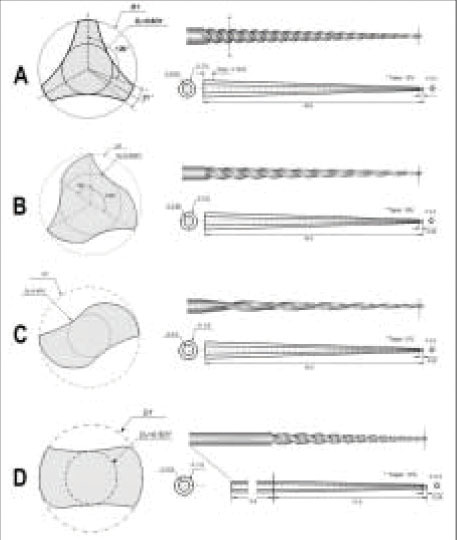
Cross-sectional and longitudinal geometries of four NiTi files; (A) ProFile .06 / #30, (B) HeroShaper .06 / #30, (C) Mtwo .05 / #30, (D) NRT .06 / #30.

Figure 2
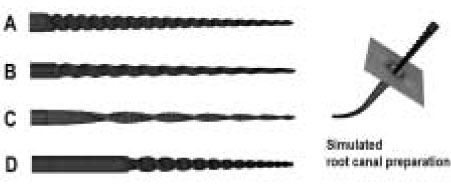
Final FE models of four NiTi files and simulated root canal; (A) ProFile .06 / #30, (B) HeroShaper .06 / #30, (C) Mtwo .05 / #30, (D) NRT .06 / #30.

Figure 3
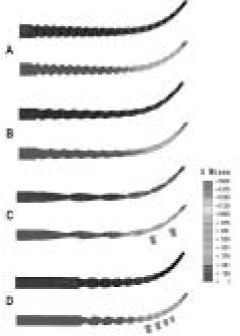
External surface and internal sectional view of stress distribution during simulated root canal shaping; (A) ProFile .06 / #30, (B) HeroShaper .06 / #30, (C) Mtwo .05 / #30, (D) NRT .06 / #30.

Tables & Figures
REFERENCES
Citations
Citations to this article as recorded by 

- Ex-Vivo Comparison of Torsional Stress on Nickel–Titanium Instruments Activated by Continuous Rotation or Adaptive Motion
Joo Yeong Lee, Sang Won Kwak, Jung-Hong Ha, Hyeon-Cheol Kim
Materials.2020; 13(8): 1900. CrossRef - Autogenous teeth used for bone grafting: a comparison with traditional grafting materials
Young-Kyun Kim, Su-Gwan Kim, Pil-Young Yun, In-Sung Yeo, Seung-Chan Jin, Ji-Su Oh, Heung-Joong Kim, Sun-Kyoung Yu, Sook-Young Lee, Jae-Sung Kim, In-Woong Um, Mi-Ae Jeong, Gyung-Wook Kim
Oral Surgery, Oral Medicine, Oral Pathology and Oral Radiology.2014; 117(1): e39. CrossRef - Analysis of crystalline structure of autogenous tooth bone graft material: X-Ray diffraction analysis
Gyung-Wook Kim, In-Sung Yeo, Su-Gwan Kim, In-Woong Um, Young-Kyun Kim
Journal of the Korean Association of Oral and Maxillofacial Surgeons.2011; 37(3): 225. CrossRef
Stress distribution for NiTi files of triangular based and rectangular based cross-sections using 3-dimensional finite element analysis



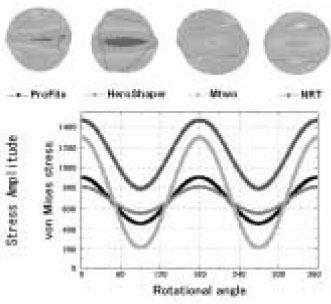
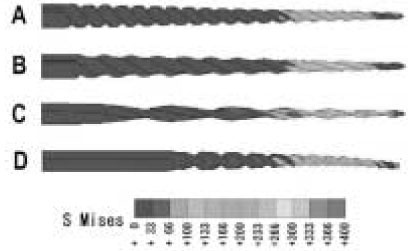
Figure 1
Cross-sectional and longitudinal geometries of four NiTi files; (A) ProFile .06 / #30, (B) HeroShaper .06 / #30, (C) Mtwo .05 / #30, (D) NRT .06 / #30.
Figure 2
Final FE models of four NiTi files and simulated root canal; (A) ProFile .06 / #30, (B) HeroShaper .06 / #30, (C) Mtwo .05 / #30, (D) NRT .06 / #30.
Figure 3
External surface and internal sectional view of stress distribution during simulated root canal shaping; (A) ProFile .06 / #30, (B) HeroShaper .06 / #30, (C) Mtwo .05 / #30, (D) NRT .06 / #30.
Figure 4
The stress changing cycles of the nodes (red point) where maximal von Mises stresses were concentrated.
Figure 5
The residual stress distribution after elastic recovery of withdrawn file (A; ProFile 326 MPa, B; HeroShaper 352 MPa, C; Mtwo 448 MPa, D; NRT 571 MPa).
Figure 1
Figure 2
Figure 3
Figure 4
Figure 5
Stress distribution for NiTi files of triangular based and rectangular based cross-sections using 3-dimensional finite element analysis

 KACD
KACD


 ePub Link
ePub Link Cite
Cite

